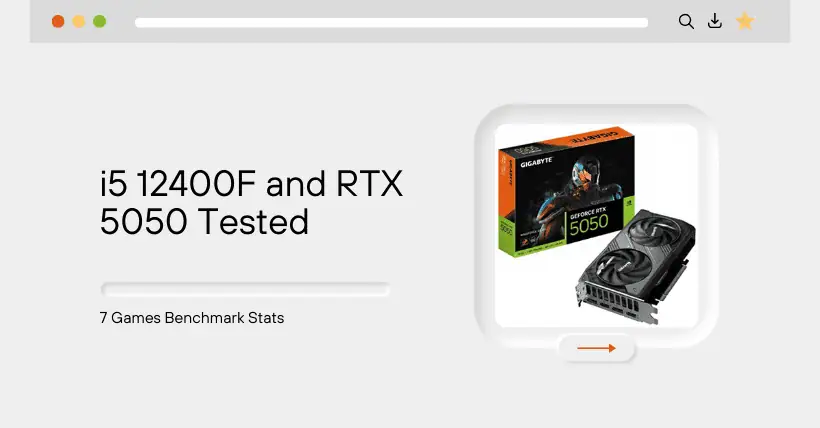01
Introduction
On June 24, NVIDIA officially released the GeForce RTX 5050 desktop version. Although it is a scaled-down version of the GeForce RTX 5060 and does not feature GDDR7 memory, thanks to its advantages in architecture and manufacturing process, its performance is roughly on par with the GeForce RTX 4060. Priced at just $249, it remains respectable.
In this context, the combination of Core i5-12400F + GeForce RTX 5050 8GB offers high cost performance. We will test the gaming performance of this configuration as a reference for those interested.
02
Specifications Overview
The GeForce RTX 5050 was released on June 24, 2025, using the GB207 GPU based on the Blackwell architecture, built on TSMC’s 4nm process. It features 2,560 CUDA cores, 80 texture units, 32 raster units, 20 streaming multiprocessors, 80 tensor cores, 20 ray tracing units, and 32MB of L2 cache.
Its base clock is 2235 MHz, with a boost clock of up to 2520 MHz. It comes equipped with 8GB of GDDR6 memory, a memory speed of 20 Gbps, 128-bit memory interface, and 320 GB/s memory bandwidth. It delivers 12.90 TFLOPS of FP32 performance and has a power consumption of 130W. The suggested retail price is $249.
The Core i5-12400F was released on January 4, 2022, using a 10nm process. It has 6 performance cores and no efficiency cores, with 12 threads in total. The base clock is 2.5 GHz and the maximum turbo frequency is 4.4 GHz. It has 7.5MB of L2 cache and 18MB of Smart Cache, with a power consumption of 65W. The suggested retail price was $184.00 to $194.00, while the current market price for tray versions is around 600 RMB.
03
Test Platform Configuration
Main specifications:
The processor is Core i5-12400F, the motherboard is MSI B760M Bomber WiFi, memory is 32GB DDR5-6000MHz, graphics card is GeForce RTX 5050 8GB, and the SSD is a Crucial P3 Plus 4TB.
04
Game Testing (i5 12400F and RTX 5050)
Seven games were tested below, all in 1080P mode.
Game 1: God of War
On the GeForce RTX 5050 platform, the average frame rate was 85 FPS, minimum 68 FPS, frame time 11.3ms, CPU usage 39%, CPU temp 58°C, memory usage 14.7GB, GPU usage 100%, VRAM usage 6.5GB, power draw 130W, GPU temp 73°C.
In this game, CPU usage hovered around 40%, fairly relaxed; memory usage ranged between 14–15GB; GPU was fully loaded; VRAM usage was between 6–7GB.
Average FPS exceeded 80, minimum FPS around 60, frame time about 11ms — runs smoothly with no issues.
Game 2: Silent Hill 2
Average FPS was 53, minimum 43, frame time 18.0ms, CPU usage 23%, temp 50°C, memory 11.8GB, GPU usage 99%, VRAM 6.3GB, power draw 130W, GPU temp 73°C.
CPU usage was about 25%, very relaxed; memory usage around 12GB; GPU nearly fully loaded; VRAM slightly over 6GB.
Average FPS exceeded 50, minimum FPS around 40, frame time around 18ms — smooth performance.
Game 3: The Witcher 3
Average FPS was 69, minimum 51, frame time 13.5ms, CPU usage 49%, temp 47°C, memory 13.7GB, GPU usage 99%, VRAM 4.2GB, power draw 130W, GPU temp 71°C.
CPU usage around 50%, moderate; memory usage between 13–14GB; GPU near full load; VRAM slightly over 4GB.
Average FPS around 70, minimum around 50, frame time around 13ms — smooth gameplay.
Game 4: Expedition 33: Light and Shadow
Average FPS was 43, minimum 36, frame time 23.6ms, CPU usage 26%, temp 57°C, memory 9.7GB, GPU usage 99%, VRAM 6.2GB, power draw 131W, GPU temp 73°C.
CPU usage about 26%, very light; memory around 10GB; GPU near full load; VRAM slightly over 6GB.
Average FPS above 40, minimum above 30, frame time around 23ms — latency too high, smoothness lacking.
Game 5: Black Myth: Wukong
Average FPS was 66, minimum 55, frame time 14.9ms, CPU usage 29%, temp 50°C, memory 15.5GB, GPU usage 99%, VRAM 6.4GB, power draw 130W, GPU temp 73°C.
CPU usage about 30%, very light; memory between 15–16GB; GPU near full load; VRAM slightly over 6GB.
Average FPS over 60, minimum over 50, frame time around 14ms — smooth performance, no pressure.
Game 6: Hogwarts Legacy
Average FPS was 65, minimum 43, frame time 17.3ms, CPU usage 41%, temp 50°C, memory 20.6GB, GPU usage 99%, VRAM 6.0GB, power draw 130W, GPU temp 72°C.
CPU usage around 40%, relatively light; memory around 21GB; GPU near full load; VRAM around 6GB.
Average FPS over 60, minimum around 40, frame time around 17ms — runs smoothly.
Game 7: The Last of Us Part II
Average FPS was 76, minimum 59, frame time 13.9ms, CPU usage 81%, temp 68°C, memory 14.3GB, GPU usage 100%, VRAM 7.4GB, power draw 130W, GPU temp 73°C.
CPU usage around 80%, relatively high; memory slightly above 14GB; GPU fully loaded; VRAM slightly over 7GB.
Average FPS over 70, minimum around 60, frame time around 13ms — smooth gameplay with ease.
05
Test Conclusion
Overall, the performance of the GeForce RTX 5050 desktop version is not as poor as previously rumored. It significantly outperforms the GeForce RTX 3060 and is roughly on par with the GeForce RTX 4060, making it acceptable.
The Core i5-12400F + GeForce RTX 5050 8GB configuration has no major weaknesses and is capable of smoothly running mainstream games. Under moderate requirements, it should remain viable for the next three years. It is a worthy option for those with limited budgets.

Disclaimer: This article is created by the original author. The content of the article represents their personal opinions. Our reposting is only for sharing and discussion purposes and does not imply our endorsement or agreement. If you have any objections, please get in touch with us through the provided channels.








